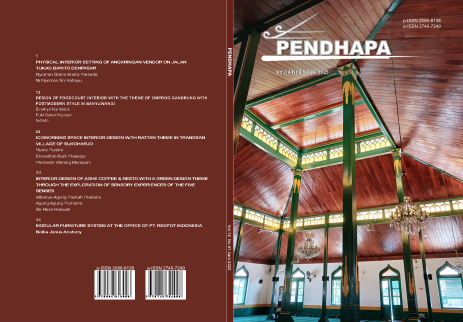Physical Interior Setting of Angkringan Vendor on Jalan Tukad Barito Denpasar
DOI:
https://doi.org/10.33153/pendhapa.v14i1.5152Keywords:
Angkringan Vendors, Physical SettingAbstract
The angkringan business is spreading rapidly in big cities throughout Indonesia with a strong characteristic with a Javanese atmosphere, cheap food and an intimate atmosphere. Another characteristic of angkringan is the mobility and territoriality of the traders, which is not very visible in angkringan on Jalan Tukad Barito Denpasar. An angkringan that uses a shop parking area that is closed at night is studied based on interior design components such as floors, walls and ceilings. Qualitative descriptive research method with observation of phenomena that occur accompanied by interviews and photo documentation. Observations were mapped using a place centered map which were grouped based on existing functions in the form of food counters, kitchens, dining areas for visitors and live music areas. Other findings are the cart design which still maintained, the goods storage system, the phenomenon of full shop rentals and the importance of live music in angkringan.Downloads
References
Dyah Kusumastuti, Retno, and Airlangga Surya Kusuma. 2022. “Angkringan Sebagai Ruang Publik Dan Sarana Interaksi Sosial Di Kota Bogor.” Jurnal Pustaka Komunikasi 5 (1): 91–105.
Harya, Henrikus Balzano. 2021. “Pengaruh Fasilitas Live Music Di Kafe Terhadap Atensi Pelanggan.” Institut Seni Indonesia Yogyakarta.
Kesumasari, D. 2019. “Understanding Physical Settings of Street Vendors in Surakarta, Indonesia.” In The 3rd International Conference on Empathic Architecture (ICEA -2019), 1:1–15. Surabaya: IOP Publishing Ltd. https://doi.org/10.1088/1755-1315/490/1/012002.
Maulana, Deni, and Izazaya Binta. 2021. “Identifikasi Teritorialitas Kawasan Angkringan Kopi Joss.” GEWANG: Gerbang Wacana Dan Rancang Arsitektur 3 (1): 13–17.
Nurzamni, Dewanti H.W., and Avi Marlina. 2019. “Identifikasi Pola Perilaku Pada Ruang Komunal Angkringan.” Jurnal Pembangunan Wilayah Dan Perencanaan Partisipatif REGION 14 (1): 66–79.
Prakoso, Taufik S. 2020. “Asal-Usul Desa Ngerangan Klaten Jadi Daerah Cikal Bakal Angkringan.” Solopos, 2020. https://www.solopos.com/asal-usul-desa-ngerangan-klaten-jadi-daerah-cikal-bakal-angkringan-1049103.
Ridho’i, Amy Manap. 2017. “Fenomena Musik Kafe Pada Coffeeccino Cafe Di Kota Pontianak.” Jurnal Pendidikan Dan Pembelajaran Khatulistiwa 6 (6).
Santoso, Slamet, and Jusuf Harsono. 2013. “Pola Mobilitas Pedagang Angkringan Di Kota Ponorogo.” JPSB 1 (2): 1–11.
Shalihah, Rahmayani Baqiyatun, and Indah Pujiyanti. 2020. “Perancangan Ruang Di Bangunan Kafe Bertema Up-Angkringan Dengan Efisiensi Kapasitas Ruang” 1 (2): 95–108.
Tjee, Monika. 2014. “Perilaku Adaptasi Masyarakat Menanggapi Area Parkir Di Jalur Pejalan Kaki (Studi Kasus Di Kawasan Ruko Bisnis Solo Baru, Sukoharjo, Jawa Tengah).” Jurnal Arsitektur KOMPOSISI 10 (6): 391–96. https://doi.org/10.24002/jars.v10i6.1098.
Widjajanti, Retno. 2009. “Karakteristik Aktivitas Pedagang Kaki Lima Pada Kawasan Komersil Di Pusat Kota Studi Kasus: Simpang Lima, Semarang.” TEKNIK 30 (3): 162–71.
Yatmo, Yandi Andri. 2008. “Street Vendors as ‘out of Place’ Urban Elements.” Journal of Urban Design 13 (3): 387–402. https://doi.org/10.1080/13574800802320889.
Downloads
Published
Issue
Section
License
Copyright (c) 2023 Nyoman Gema Endra Persada, Nyoman Sri Rahayu

This work is licensed under a Creative Commons Attribution-ShareAlike 4.0 International License.
Authors who publish with Pendhapa agree to the following terms:
- Authors retain copyright and grant the journal right of first publication with the work simultaneously licensed under a Creative Commons Attribution License (CC BY-SA 4.0) that allows others to share the work with an acknowledgment of the work's authorship and initial publication in this journal.
- Authors are able to enter into separate, additional contractual arrangements for the non-exclusive distribution of the journal's published version of the work (e.g., post it to an institutional repository or publish it in a book), with an acknowledgment of its initial publication in this journal.
- Authors are permitted and encouraged to post their work online (e.g., in institutional repositories or on their website) prior to and during the submission process, as it can lead to productive exchanges, as well as earlier and greater citation of published work.

This work is licensed under a Creative Commons Attribution-ShareAlike 4.0 International License.









